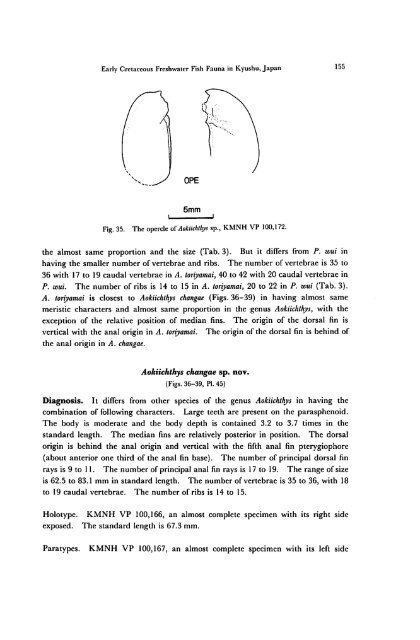Early Cretaceous Freshwater Fish Fauna in Kyushu, Japan
Early Cretaceous Freshwater Fish Fauna in Kyushu, Japan
Early Cretaceous Freshwater Fish Fauna in Kyushu, Japan
Create successful ePaper yourself
Turn your PDF publications into a flip-book with our unique Google optimized e-Paper software.
<strong>Early</strong> <strong>Cretaceous</strong> <strong>Freshwater</strong> <strong>Fish</strong> <strong>Fauna</strong> <strong>in</strong> <strong>Kyushu</strong>, <strong>Japan</strong> 155<br />
OPE<br />
5mm<br />
Fig. 35. The opercle ofAokiichthys sp., KMNH VP 100,172.<br />
the almost same proportion and the size (Tab. 3). But it differs from P. wui <strong>in</strong><br />
hav<strong>in</strong>g the smaller number of vertebrae and ribs. The number of vertebrae is 35 to<br />
36 with 17 to 19 caudal vertebrae <strong>in</strong> A. toriyamai, 40 to 42 with 20 caudal vertebrae <strong>in</strong><br />
P. wui. The number of ribs is 14 to 15 <strong>in</strong> A. toriyamai, 20 to 22 <strong>in</strong> P. wui (Tab. 3).<br />
A. toriyamai is closest to Aokiichthys changae (Figs. 36-39) <strong>in</strong> hav<strong>in</strong>g almost same<br />
meristic characters and almost same proportion <strong>in</strong> the genus Aokiichthys, with the<br />
exception of the relative position of median f<strong>in</strong>s. The orig<strong>in</strong> of the dorsal f<strong>in</strong> is<br />
vertical with the anal orig<strong>in</strong> <strong>in</strong> A. toriyamai. The orig<strong>in</strong> of the dorsal f<strong>in</strong> is beh<strong>in</strong>d of<br />
the anal orig<strong>in</strong> <strong>in</strong> A. changae.<br />
Aokiichthys changae sp. nov.<br />
(Figs. 36-39, PI. 45)<br />
Diagnosis. It differs from other species of the genus Aokiichthys <strong>in</strong> hav<strong>in</strong>g the<br />
comb<strong>in</strong>ation of follow<strong>in</strong>g characters. Large teeth are present on the parasphenoid.<br />
The body is moderate and the body depth is conta<strong>in</strong>ed 3.2 to 3.7 times <strong>in</strong> the<br />
standard length. The median f<strong>in</strong>s are relatively posterior <strong>in</strong> position. The dorsal<br />
orig<strong>in</strong> is beh<strong>in</strong>d the anal orig<strong>in</strong> and vertical with the fifth anal f<strong>in</strong> pterygiophore<br />
(about anterior one third of the anal f<strong>in</strong> base). The number of pr<strong>in</strong>cipal dorsal f<strong>in</strong><br />
rays is 9 to 11. The number of pr<strong>in</strong>cipal anal f<strong>in</strong> rays is 17 to 19. The range of size<br />
is 62.5 to 83.1 mm <strong>in</strong> standard length. The number of vertebrae is 35 to 36, with 18<br />
to 19 caudal vertebrae. The number of ribs is 14 to 15.<br />
Holotype.<br />
exposed.<br />
Paratypes.<br />
KMNH VP 100,166, an almost complete specimen with its right side<br />
The standard length is 67.3 mm.<br />
KMNH VP 100,167, an almost complete specimen with its left side

















